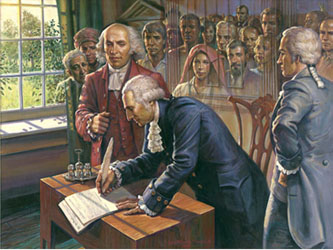(image source: Famously Dead)
The Legal History Blog signalled two new papers by Daniel J. Hulsebosch (NYU School of Law):
From Imperial to International Law: Protecting Foreign Expectations in the Early United Statesand appears in UCLA Law Review Discourse 65 (2018): 4-18:
This Essay argues that several principles associated with modern international investment law and dispute resolution arose in the wake of the American Revolution, as the revolutionaries and Britons sought to restructure trade relations, previously regulated by imperial law, under new treaties and the law of nations. They negotiated such problems as the currency in which international debts would be paid; the ability of foreign creditors pursue domestic collection remedies; whether creditors had to exhaust those remedies before their nation could resort to international arbitration; and the form of state-state arbitration of private disputes. The specific setting of these negotiations — the aftermath of a colonial settler revolution — narrowed the compass of disagreement, compared to many later postcolonial negotiations. In addition, the negotiations assumed that the exhaustion of national remedies remained the standard method of resolving private debt disputes. Notwithstanding these important differences, the principles and institutions developed after an imperial civil war influenced the development of international investment law.The second is Being Seen Like a State: How Americans (and Britons) Built the Constitutional Infrastructure of a Developing Nation, which appears in the William & Mary Law Review 59 (2018): 1239-1319:
This Article develops the argument that the Federal Constitution of 1787 was conceptualized, drafted, and put into operation not only for American citizens but also for foreign audiences. In a world without supranational governing institutions, a constitution — at least, the Federal Constitution — might serve to promote peaceable international relations based on reciprocal trade and open credit. That at least was the Enlightenment-inflected hope. Did it work? If early Americans engaged in constitution-making in large part to demonstrate their capacity for self-government, self discipline, and commercial openness to foreign audiences, did anyone notice? Or was it all, regardless of diplomatic purposes and consistent with the conventional account of the American Founding, just an intramural affair? This Article argues that many foreigners did notice, not least because some of them had participated in the process of reform. Although no foreigners intervened directly in drafting or ratification, international demands, incentives, and reactions shaped the way that leading American Framers pursued constitution making. After a “foreign ratification debate” that stretched into the first years of the Washington Administration, Britain normalized diplomatic relations with the United States and substantial capital investment followed. In 1791, the British Board of Trade approvingly analyzed the Constitution in a report designed to guide the Privy Council as it drafted instructions for its first official envoy to the United States. Within fifteen years, Britons were the largest holders of foreign investment in the United States, including state and federal “domestic debt,” or the restructured wartime certificates and loans that had floated the Revolution. In sum, Britons ultimately financed much of the project of American independence, and contemporaries believed that these credit relations would reduce, without eliminating, the prospect of renewed war.


No comments:
Post a Comment